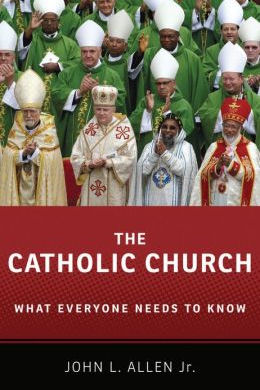
|
Posted April 22, 2013
Book: The Catholic Church: What Everyone Needs to Know Author: John L. Allen Oxford University Press. New York. 2013. Pp. 272 An Excerpt from the Jacket:
An Excerpt from the Book: What are the big challenges facing the Catholic Church in the United States? First are the new headaches, and new opportunities, created by demographic change. Pastorally, Catholic leaders in America will be pressed to ensure that the growing Hispanic community doesn"t exist in a sort of parallel universe from the traditional centers of Catholic life, but is fully integrated into the life and mission of the Church. Socially and politically, bishops and other leaders will be called upon to do what they did in the nineteenth century, which is to act as tribunes for immigrant rights and as a bulwark against social exclusion. They"ll also have to embrace the graying of their congregations, figuring out creative ways to encourage the elderly cohort in the Church to invest their considerable time and treasure in Catholic causes, rather than feeling abandoned and neglected. Second, the competitive dynamics of American religion have hardly diminished in the early twenty-first century, and there"s evidence to suggest that the Catholic Church ought to be worried about its "market share." The 2008 Religious Landscape Survey from the Pew Forum documented a remarkable fluidity in religious affiliation in the country --- almost half of American adults have either switched religions or dropped their ties to religion altogether. For Catholicism, the banner headline was that there are now twenty-two million ex-Catholics in America, by far the greatest net loss for any religious body. One in three Americans raised Catholic has left the church. Were it now for immigration, Catholicism in America would be contracting dramatically: for every one member the church adds, it loses four. While those numbers might suggest a mass exodus from Catholicism, the picture is more complicated. The Church actually retains 68 percent of those born in the faith into adulthood, a lower rate than Hinduism (84 percent) as well as Judaism, Orthodoxy, and Mormonism (all slightly over 70 percent), but well ahead of all forms of Protestantism. Baptists retain just 60 percent of their members, Lutherans 59 percent, Pentecostals, 47 percent and Presbyterians 40 percent. The Jehovah"s Witnesses retain a stunning low 37 percent of childhood members as adults, meaning they have an exit rate of almost two-thirds. What these others religious outfits seem to do better than the Catholic Church, however is to recruit. . . . . Here"s the bottom line: In comparison to other religious groups, the Catholic Church"s struggles aren"t really with pastoral care but missionary muscle. Overall, Catholicism serves existing members fairly well, as measured by the share that chooses to stick around. What it doesn"t do nearly as well is evangelize. To put all that into crass capitalistic terms, in America"s highly competitive religious market place, the real Catholic problem isn"t customer service but new sales. Ramping up the Church"s missionary capacity thus seems like a fairly urgent priority. Third, the Catholic Church faces an increasingly difficult series of church-state related battles, on fronts such as state and federal policy on abortion, contraception, and gay marriage; the ability of church-affiliated schools, hospitals, and charities to uphold Catholic teaching while also receiving public funding; and the rights of conscientious objection for religious individuals and institutions. Table of Contents: 1. The Catholic Church 101 2. Historical highlights and lowlights 3. The church outside "the Church" 4. The life of the mind 5. Worship 6. Angels, demons, and saints 7. Faith and politics 8. Catholicism and sex 9. Catholicism and money 10. Crisis and scandal 11. Rome and America 12. New frontiers 13. Recommended readings |
|
